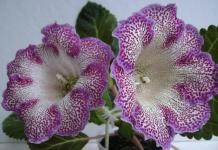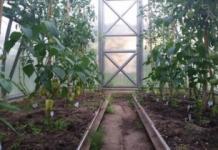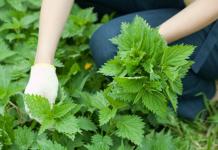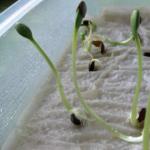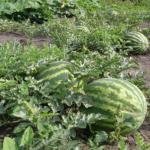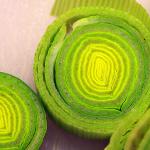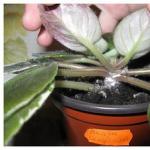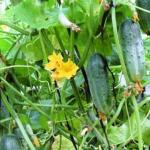Gloxinia is one of the most popular indoor plants all over the world. She gained popularity, first of all, because of her gorgeous flowering.
Despite the fact that the flower is not capricious and does not require special conditions, it is worth caring for, even after it has bloomed.
Gloxinia flowering dates
Gloxinia is characterized by lush and long-lasting flowering, which begins at 3–4 years of age. Typically flowering lasts from April to August. But the plant can begin to produce the first buds in March, and the last ones in October. The active flowering phase occurs in May - June.  The abundance of flowering is influenced by factors such as the quality of care for indoor crops and the conditions in which it grows (lighting, humidity and temperature indicators). Often, 20 buds are formed on a bush at a time, and in a season the plant can produce a hundred flowers.
The abundance of flowering is influenced by factors such as the quality of care for indoor crops and the conditions in which it grows (lighting, humidity and temperature indicators). Often, 20 buds are formed on a bush at a time, and in a season the plant can produce a hundred flowers.
Features of the period under review
Gloxinia flowers grow singly, emerging from the axils of the leaves. They are shaped like bells. The corolla is formed in the form of a tube. The color of the flowers depends on the variety. The main colors are white, pink, red and purple. Petals can be terry or smooth.  During flowering, certain conditions must be organized for indoor culture. Firstly, it is necessary to satisfy its need for light, but to protect it from the rays of the sun hitting it at right angles. It is better to place the flower on a windowsill facing north. However, at the same time monitor his condition. If there are negative changes in the appearance of the flower, for example, the shoots are stretched, buds are not formed, the petals have become faded, then you should move it to the western side. When grown on southern or eastern windows, shading is required.
During flowering, certain conditions must be organized for indoor culture. Firstly, it is necessary to satisfy its need for light, but to protect it from the rays of the sun hitting it at right angles. It is better to place the flower on a windowsill facing north. However, at the same time monitor his condition. If there are negative changes in the appearance of the flower, for example, the shoots are stretched, buds are not formed, the petals have become faded, then you should move it to the western side. When grown on southern or eastern windows, shading is required.
Secondly, you need to control the temperature in the room. They should not exceed +28°C. Since high temperatures negatively affect plant growth, they lead to rapid drying of flowers and the absence of new buds.  Gloxinia does not tolerate temperature changes or drafts well. Therefore, when ventilating, you need to make sure that it does not fall under air currents.
Gloxinia does not tolerate temperature changes or drafts well. Therefore, when ventilating, you need to make sure that it does not fall under air currents.
Important! During the flowering period, faded flower stalks should be promptly removed. This will allow new buds to form.
Thirdly, high-quality watering and fertilizing will be required. After all, it is during the flowering period that the plant requires the most nutrients and strength. Watering at this time should be plentiful using exclusively warm, settled water. Spraying is also required, but not of the ground organs of the flower, but of the space around it. Because if the air is too dry, the buds dry out without opening.  Gloxinia is fed from April to early August once every 7 days. They use fertilizers specially designed for flowering indoor crops, choosing formulations with a predominance of potassium and phosphorus and a minimum nitrogen content. Fertilizers should be applied to pre-moistened soil so as not to cause burns to the roots.
Gloxinia is fed from April to early August once every 7 days. They use fertilizers specially designed for flowering indoor crops, choosing formulations with a predominance of potassium and phosphorus and a minimum nitrogen content. Fertilizers should be applied to pre-moistened soil so as not to cause burns to the roots.
What to do and how to care for a flower after flowering?
After the first flowering, which ends in summer, gloxinia often produces buds again, closer to autumn. The second time, fewer flowers are formed on the plant than the first time. In addition, they fade faster. At the end of repeated flowering, gloxinia begins a period of rest. The flower needs to be prepared for it, namely, trimmed, changed the watering regime, and moved to a room with a cool temperature.
Did you know? Gloxinia is named after the German botanist Benjamin Peter Gloxinn, who first described it in the 18th century. Second title– Sinningia–The flower was received in 1825 from the surname of the chief botanist of the University of Bonn, Wilhelm Sinning.
Trimming
 After flowering, which ends in summer (June - July), the plant needs to be pruned. Using sharp, disinfected pruners or scissors, remove the top leaves along with the stem. It is worth leaving a couple of lower leaves on a short stem.
After flowering, which ends in summer (June - July), the plant needs to be pruned. Using sharp, disinfected pruners or scissors, remove the top leaves along with the stem. It is worth leaving a couple of lower leaves on a short stem.
Next, you need to feed the plant with growth stimulants, for example, Epin, Zircon. When it produces stepsons in the axils of the remaining leaves, they also need to be removed, leaving only 2–3 of the strongest ones. Trimmed stepsons are suitable for flower propagation.
After pruning, gloxinia should be fed with complex mineral fertilizer. Soon after feeding it should bloom a second time.
After flowering again, the above-ground part should die off naturally. The tuber will go into a sleep state and will no longer feed it. From about the 20th of October, all dry ground parts must be removed, leaving a stump not exceeding 1–2 cm in height.
Fertilizer application
After complete flowering, around September, the plant should be fertilized for the last time of the season. This time you need to use a mineral fertilizer that does not include nitrogen. This could be, for example, monopotassium phosphate. Nitrogen during this period is harmful for indoor crops, as it stimulates the growth and expansion of green mass, which means it will not allow the flower to go into a dormant state.
Did you know? It is believed that not only certain stones and elements are suitable for zodiac signs, but also indoor plants. According to the flower horoscope, gloxinia should be grown by Taurus to gain stability in the material plane.
Watering mode
To stimulate the flower’s transition to winter mode, it is necessary to sharply reduce the number and volume of watering to once every 2 weeks. After pruning the ground part, scanty moisture will need to be carried out for another 2-3 weeks. In the future, you will need 1 moisturizing every 2 months. It will be necessary to resume the previous watering regime in February, when the plant wakes up after winter hibernation and begins to grow.  Watering is done with warm tap water, standing for 1–2 days.
Watering is done with warm tap water, standing for 1–2 days.
Why doesn't gloxinia bloom anymore?
Unfortunately, some gardeners are faced with the fact that gloxinia stops blooming. This situation can result from several reasons that are due to the fault of the owner of the flower:
- Excess nitrogen in the soil. This happens if the flower is fed with fertilizers with a composition that does not correspond to the period of its development. Thus, nitrogen fertilizing is important at the beginning of the growing season, before flowering. During the release of flowers and later, they only cause harm. At this time, only phosphorus- and potassium-containing fertilizers are needed.
- Insufficient lighting. To lay buds and form flowers with bright petals, the plant needs sufficient lighting with diffused sunlight. The optimal duration of daylight hours is 10–12 hours. If there is not enough daylight for gloxinia, you need to organize additional lighting.
- The pot is not selected correctly. Gloxinia requires a low and wide container with a diameter of 9–15 cm. In a container that is too large, the plant devotes all its energy to the active development of the tuber, while the growth of the above-ground part and flowering suffer.
- Long absence of transplantation. Gloxinia must be replanted annually. If this is not done, the soil will be depleted, which means the plant will have no place to get nutrients from to form buds.
- Planting in unsuitable soil. The correct growth and development of this indoor crop can only be achieved by planting it in nutritious, loose, moisture- and air-permeable soil. It can be purchased at a specialized store or mixed with your own hands from deciduous soil (1 part), peat (1 part), sand (0.5 parts), humus (1 part), sawdust. Recommended soil acidity is 5.5–6.5 pH.
- Improper conditions and care in winter. There is no need to neglect the recommendations for creating conditions and care during the period when the plant is “sleeping”. Let us remind you that starting from October, it is necessary to cut off the above-ground part, reduce the number of waterings and move the pot to a dark room with temperatures of +12…+15°C. It is strictly forbidden to apply fertilizers.
Video: Why gloxinias don’t bloom
So, in order for gloxinia to delight every year with bright, lush and long-lasting flowering, it needs certain care, as well as the creation of conditions for winter sleep.
An indoor flower, it is quite light-loving, although it does not tolerate direct sunlight. If you put it on a sunny windowsill during the flowering period, it will quickly bloom and fade. Therefore, you need to adjust its location depending on the time of year.
So, in the spring, when the sun is not yet too hot and scorching, gloxinia will feel good on the south side of the house, but with the onset of summer it is better to move it to the eastern or western window.
In general, gloxinia loves long daylight hours. In order for it to bloom fully, it needs 12-14 hours of lighting. If this condition is not met, the plant develops not into buds, but into greenery. The buds will probably not form at all. Whereas, with sufficient time and brightness of lighting, the plant will delight you with its lush and long flowering.
Gloxinia flower - care
It is better to plant gloxinia tubers in a mixture of leaves, peat and sand in a ratio of 1:1:0.5. The soil should be loose and well ventilated. Choose shallow and wide dishes made of clay or plastic. Place a layer of drainage at the bottom of the pot.
Tubers should be planted in February-March. During this period they are already beginning to sprout. Before planting, treat them in a weak solution of potassium permanganate to disinfect. After planting, the tuber is covered with about 1 cm of soil from above.
After planting, the pot is placed in a window where there is enough light, but there is no direct sunlight. The pot is first placed in a bag, which must be opened daily for 10-15 minutes for ventilation. After the leaves have sprouted, the bag can be removed.
Gloxinia should be watered with soft water at room temperature, avoiding it getting on the roots and leaves of the plant. In cloudy weather you need to water less often than on warm sunny days.
You definitely need to know how to fertilize gloxinia, since not all types of fertilizer are suitable for this. In general, after planting, gloxinia does not need to be fed for 1.5-2 months. After this period has expired, you can add organic approvals to the pot, alternating them with mineral ones. Moreover, do this along the edge of the pot and an hour after watering. You need to feed no more than once every 10 days.
Before flowering, choose fertilizers containing potassium nitrate and ammonium nitrate. During the flowering period - and phosphoric acid nitrate. Bird droppings are preferable among organic fertilizers.
Gloxinia after flowering
Beginners in the business of growing such plants are often surprised that the plant begins to die in the fall and wonder what to do next after the gloxinia has faded? There is no need to be scared and think that the plant has died.
After flowering, gloxinia begins a period of rest. What to do when gloxinia has faded - you need to reduce the intensity of watering, and after the leaves completely dry out, stop watering it altogether.
When gloxinia has bloomed and its above-ground part has completely died off, care must be taken to preserve the tuber until the next season. Rest usually lasts 3-4 months.
You can store the tuber during this period either in a pot,  placing it in a place with a temperature of 10-15 degrees Celsius, occasionally moistening the soil, or digging them up and clearing them of soil. In the second case, the tubers are placed in sand, moistened and stored in a cool place. The bottom shelves of the refrigerator or its door are usually used as such a place. The tubers should be inspected periodically and, if there are signs of drying out, lightly moistened.
placing it in a place with a temperature of 10-15 degrees Celsius, occasionally moistening the soil, or digging them up and clearing them of soil. In the second case, the tubers are placed in sand, moistened and stored in a cool place. The bottom shelves of the refrigerator or its door are usually used as such a place. The tubers should be inspected periodically and, if there are signs of drying out, lightly moistened.
At the end of February - beginning of March, the tubers can be replanted in the pot, repeating the entire procedure described above. The gloxinia will germinate and bloom again.
Gloxinia is an amazing plant that gardeners successfully grow at home. It attracts those around it with incredibly beautiful flowers that have won many hearts and delight the eye throughout the summer. But to ensure that your pet never disappoints you, you should take proper care of it.
Gloxinia indoors: will it bloom or not?
The bell-shaped flowers of Gloxinia instantly captivate those around them.
Because of this similarity, gloxinia got its name: Gloken translated from German means “bells”.
Their coloration is characterized by a variety of colors: pink, red, burgundy and purple bells are found, but most often white. In addition, they can be either terry or non-terry; multi-colored, as well as with a colored border around the edge. The scent of the flower depends on the type of plant. There are varieties without aroma, and there are fragrant with a wonderful smell.
With proper care, up to a dozen buds can form on the peduncle
One of the main advantages of this plant is its cap flowering. Probably every gloxinia grower strives to get exactly this. But for gloxinia to bloom like this, you need to try to collect as many buds as possible.
When gloxinia is propagated using leaves, it takes 4 months to see the plant bloom.
Remember that the number of collected peduncles and opened bells on gloxinia depends directly on the care:
- the plant requires bright and diffused lighting with a long daylight hours - 12–14 hours;
- loose nutritious soil and regular fertilizing. They are applied according to the periods of plant development: during the growth of green mass - some, during the formation of buds - others, and in gardening stores you can purchase universal fertilizers for indoor plants, suitable for any stage of the plant’s life. So, during the growth of green mass, gloxinia is fed with aqueous solutions of mineral fertilizers. In April they are alternated with phosphorus, which promotes the formation of buds. It is at this time that the plant begins to form flower stalks and prepares for flowering. Do not overdo it with phosphorus: it is added once a month.
The flowering period of gloxinia can be extended by stimulating it to re-bloom, which is usually not so abundant. To achieve re-blooming, first carefully examine the plant and find the growing point.
If after the first flowering gloxinia has a visible growth point, then soon it will delight you with the appearance of its luxurious bells for the second time. If the plant does not have a growing point:
- Cut off almost all the leaves, first leaving 2-4 lower leaves.
- After some time, shoots will appear in the axils of the gloxinia. Leave one or two of the strongest ones and pinch off the weak ones.
- After this, feed the gloxinia with nitrogen fertilizer to accelerate the growth of green mass.
- When the plant begins to form buds, use phosphorus fertilizer to stimulate flowering.
It is also possible that gloxinia blooms throughout the summer and does not have enough strength for another flowering: in this case, there is no need to prune it, it will prepare itself for the winter.
Preparing for winter
In autumn, after secondary flowering, gloxinia prepares for a period of rest, necessary to gain strength for future flowering. Gloxinia leaves gradually fade. What to do in this case?
If gloxinia continues to bloom in November, allow the plant to bloom and then reduce watering.
At this time, gloxinia should not be fed. The only thing that is practiced: to prepare for the dormant period, you can fertilize the plants once with potassium fertilizer (for example, potassium monophosphate). When the leaves completely wither, stop watering completely.
To prepare the plant for wintering, cut off its yellowed and wilted foliage, leaving a stump of 1–2 cm
Do not immediately tear off the entire above-ground part of the gloxinia: for successful wintering and subsequent awakening of the plant, nutrients must gradually move from the leaves and stem to the tuber.
There are two ways to store gloxinia tubers in winter:
- in a pot with substrate;
- in a plastic bag (dug up tuber).
Let's get to know them in more detail.
Wintering in the ground
If your plant remains in the pot for the winter:
- Cover the container with tubers (you can sprinkle it with sand) with a tray and pack it in a plastic bag (no need to tie the bag).
- Hide gloxinia in a cool place with a temperature of at least 10 o C.
There is a drawback to such storage: you need to make sure that the tubers do not dry out and the plant does not wake up ahead of time.
If your gloxinia remains in the ground for the winter, moisten the soil once a month so that the tuber does not dry out
Storing a dug up tuber
Some gardeners dig gloxinia tubers out of the pot for winter storage and put them in a bag. This storage method is good because the tubers do not wake up prematurely.
To “put them to bed” correctly, you need to:
- In the fall, remove the tubers from the pot and place them in a plastic bag.
- Inside the bag, add vermiculite mixed with moistened soil or sawdust. Put it in the refrigerator for 2-3 months in the vegetable storage compartment, where the temperature is maintained at about 12 o C. In January, remove the tubers and place them in a warm and bright place so that they awaken.
Write on the labels of the bags the gloxinia variety and the date the tuber was laid for winter, because waking up early can negatively affect flowering
Video: preparing gloxinia for winter
"Restless" wintering
If gloxinia is not put to sleep for the winter, its stem will stretch out and become ugly, and this will also affect the flowering: the tuber still needs rest. But young plants grown from seeds do not have a dormant period: otherwise the small tuber may die over the winter.
When keeping gloxinias that are not dormant in winter, they need additional lighting
Care after the rest period
In January, after wintering, when the first shoots hatch, gloxinia tubers are planted in new, more nutritious soil. To replant a tuber:
- Carefully remove it from the ground and cut off the bad roots (rotten areas are also cut off with a knife, sprinkling the cuts with charcoal or ash).
- Before planting, for disinfection, the tubers are dipped in a weak solution of manganese for half an hour, dried for about a day and planted in the ground, covered with film until the first leaves appear from the ground.
- The greenhouse is periodically ventilated by removing the film in the morning and evening for one hour.
- After the first pair of leaves appears, the film can be removed, and soil must be added to the pot to completely cover the tuber with soil without burying the sprouts.
It may also be that gloxinia wakes up too early and the first leaves appear from the ground prematurely. In this case, if the tuber is large and strong, then it is better to remove the early leaf so that the plant does not stretch in the future.
Don’t worry: when you remove the first shoots, new ones will grow in their place after a while
Doesn't bloom: 9 "why"
It happens that even after a good winter rest, gloxinia does not bloom. As a rule, the main reasons for the lack of flowers in gloxinia are:
- Improper care and storage.
- Old tuber. In order for gloxinia to bloom, it is necessary to increase watering. Water even slightly dry soil.
- Infection or overfeeding of the tuber: the plant loses strength, which in the future is simply not enough for flowering.
- Contaminated soil. When the soil is infested with pests, transplantation into another soil, pre-treated with boiling water, is necessary.
- Lack of light at elevated air temperatures: Gloxinia's stems become elongated, the flowering period begins much later or is completely absent.
- Improper use of fertilizer. The plant will react to an excess or lack of fertilizer with yellowing foliage and poor flowering. To avoid this, apply fertilizer strictly according to the instructions on the package.
- Draft. In the cold and in a draft, gloxinia flowers curl. The favorable air temperature for it is 18–20 o C. Move the flower pot to a warmer place without drafts.
- Insufficient air humidity. Dry indoor air leads to delayed flowering. Humidify the air by placing a glass of water next to the gloxinia.
- Incorrect selection of container. Ideally, you need a low and wide pot. In a large pot, the plant spends energy on tuber growth rather than flowering. Ideal proportions for pots: diameter - 12 cm, height - 10 cm.
With proper care, a gloxinia tuber can live for about ten years, delighting others with luxurious velvet bells. The more powerful the tuber, the more flower stalks are formed on it, so be careful when choosing it. And one more tip: to prolong the flowering of gloxinia, remove faded inflorescences in time. And remember, in order for this plant to grow and bloom easily in your home, you need to put in a little effort.
Flower growers are often at a loss as to what to do after their plants finish flowering at home or in the garden. In today's article you will learn what to do next after gloxinia has bloomed?
Gloxinia has faded - what to do next?
Gloxinia blooms well and continues to delight with flowering if you implement basic care and monitor the condition of the plant. The flowering of young gloxinias is not as lush as that of older plants, but they produce excellent leaf mass and gradually form a strong stem. To stimulate flowering, leave only 2 sheets on the bottom- this helps release nutrients into the gloxinia stem and buds.
What to do after gloxinia blooms:
- Trim the stem;
- Leave the lower leaves;
- Start feeding the flower;
Nitrogen components are suitable for fertilizer, as they stimulate the growth of green mass. The feeding system changes from the moment the buds form - they already apply phosphorus-potassium fertilizers , reducing nitrogen.
What to do after the second flowering of gloxinia:
- Reduce watering;
- Move to a less lit place;
- Do not feed;

 How to store gloxinia tuber after flowering:
How to store gloxinia tuber after flowering:
- At a temperature of 12° C;
- In the dark;
- No exposure to moisture or drafts;
Storing a gloxinia tuber can be done in two ways: place it in a pot in a dark and cool place, or transplant into sand. Often, gardeners dig up and completely clean a gloxinia tuber after flowering, leaving it in a container and not filling it with anything. You can store it this way, but the tuber dries out, but moisture is still retained in the soil, and you can periodically add a little water. You can store gloxinia tuber in the refrigerator- this way it’s more convenient to inspect it, check if it’s dry, you can moisturize and wake it up at any convenient time, but artificial lighting should not affect it, so wrap it with an opaque cloth.
After a period of dormancy, the gloxinia tuber is awakened in the spring. Gradually it will begin to sprout in the soil mixture in the pot. In the sand or in dry storage, the tuber wakes up and needs to be planted before the start of the new season. Read, The dormant period contributes to future lush flowering - the plant needs rest. No less important is the planting technique, the choice of soil mixture, pot and location. Taken together, the techniques will give you a beautiful, flowering plant for many years.
↓ Write in the comments what do you do after gloxinia blooms? How to store a flower tuber? Send photos of gloxinias in storage.
(No ratings yet, be the first)
READ ALSO:
Why do gloxinia leaves curl?
How does gloxinia reproduce at home?
How to transplant gloxinia correctly?
Why do gloxinia buds dry out?
Why doesn't indoor gloxinia bloom?
How to wake up gloxinia tuberosa?
- This is an unusually delicate and beautiful flower, upon seeing which you will definitely want to have it at home. Refers to decorative indoor plants with beautiful bell-shaped flowers. One bush can form up to twenty bells at the same time. The flowers themselves, of different colors, depending on the variety of gloxinia, can be smooth, terry, or wavy.
The indoor flower loves light, but is afraid of direct sunlight. The leaves may become scorched and the bells may wilt.
Therefore, at home, gloxinia is placed in accordance with these recommendations. The place where the flowerpots will be placed should be well illuminated with diffused light. For optimal growth and bud formation, at least twelve to fourteen hours of daylight are needed. If the plant does not receive the necessary lighting, then buds will not form. Therefore, with the onset of spring, when daylight hours are not long enough, artificial lighting is used. If you properly care for gloxinia at home, it will delight you with abundant and long-lasting flowering.
Care after flowering
When gloxinia has bloomed for the first time in the season, this usually happens in May-June; if the plant is young (1-2 years of age), then there may be few flowers; they all need to be cut off along with the leaves, leaving only the lower two pairs. This must be done, it happens that novice gardeners feel sorry for the plant and do not prune it, then there is no hope for further flowering this season. Therefore, when gloxinia faded. Without any regret, we cut off the top part, and from the remaining parts of the cut leaves, young shoots will appear in a few days. It is they who will develop and form a new full-fledged bush, which, if properly cared for, will again form buds and bloom in a month. Now is the time when Gloxinia needs help. At home, it is divided into two stages:
- introduction of nitrogen-containing substances during crown formation;
- Fertilize with phosphorus fertilizer when the first buds appear.
If everything is done correctly, then at home, around July, gloxinia begins its second flowering period and lasts until the end of October. All this time, the plant must be properly cared for: watered, fertilized once every two weeks.
But with the onset of autumn, they reduce the frequency of watering and stop feeding. Gradually, the flower needs to be prepared for winter dormancy. When gloxinia has stopped flowering and the leaves gradually begin to turn yellow and die, you need to stop watering, and after a week, completely cut off the surface part of the bush, leaving literally two centimeters of the main stem. You need to leave the flower alone and just observe. When the soil is completely dry, the remaining stem also dries, it is also removed. And nothing remains of the once flowering plant except the tuber.
Storing gloxinia during dormancy
If the tuber will overwinter in its usual place - a flower pot, then after the last dried part of the stem is cut off, the soil in the pot should be lightly watered, and the pot itself should be covered with a thick cloth and put in a cool place (under the bathroom, cellar, etc.). d). Periodically you need to inspect the condition of the tuber and lightly water it as needed, no more than once a month.

When storing in wet sand, the tubers should first be carefully removed from the soil and cleaned of soil, then they are placed in pre-moistened sand, which is located in a special container. The container with the tubers is stored in a cool place; you can use the refrigerator for this and place the container with the tubers in vegetable drawers, or you can take them to the cellar. The tubers must be looked after during the entire storage period. They are inspected and moistened as necessary.
Awakening of gloxinia after a period of dormancy. Landing in the ground
The optimal time when the tubers come to life and the first buds appear on them is the end of February or the beginning of March. But at home, when either the temperature was too warm or the watering was plentiful, gloxinia may wake up earlier and sprout. What to do in this case? There are two ways out:
- First, when the tuber is five or more centimeters in size, the sprouts can be broken off and thus extend the dormant period.
- Secondly, it is used for young plants; the tuber with sprouts is planted in a pot with new soil and full care begins in accordance with all the rules.
And so, after the tubers awaken, they need to be planted in the soil, which is prepared at home as follows. You need to take equal quantities of soil, last year's leaves, peat and a little sand. The soil prepared in this way turns out to be soft and airy, which means it allows air and moisture to pass through well, which is simply necessary for gloxinia. Before planting tubers in a pot, you must make holes in it to drain water and lay a drainage layer. The tubers themselves must be treated with a solution of potassium permanganate. Gloxinias are planted in the soil to a depth of no more than a centimeter. After planting, the soil is watered, and the pot is covered with film or glass and placed in a warm, well-lit place. It is necessary to ventilate every day and, if necessary, moisten the soil. When the first leaves sprout, the covering is completely removed. And constant care continues. Water the young shoots only with warm and soft water. At home, let it sit for 24 hours, and then carefully moisten the soil so as not to flood the leaves and roots. You should not over-moisten the soil, as this can lead to rot on the tubers and death of the plant.
For the proper formation of gloxinia after a period of dormancy, it needs a certain amount of nutrients, which it can obtain from soil fertilized with special preparations.
At home, fertilizers must be applied correctly. The first feeding is carried out no earlier than a month and a half after planting the tubers in the ground. To do this, use dry forms of mineral and organic fertilizers, which are applied directly to the moist soil in the pot, one at a time. Fertilizers must be applied extremely carefully so that they do not get on the tuber and stems with leaves, along the very edge of the pot, no earlier than an hour after watering.
Feeding is carried out once every ten days. You can use complex fertilizer for ornamental and flowering plants. Without additional support, in the form of minerals and organic matter, it is unlikely that it will be possible to grow a full-fledged flower with beautiful greenery and achieve abundant and long-lasting flowering. But excessive enthusiasm for fertilizing is fraught with negative consequences for the flower.
